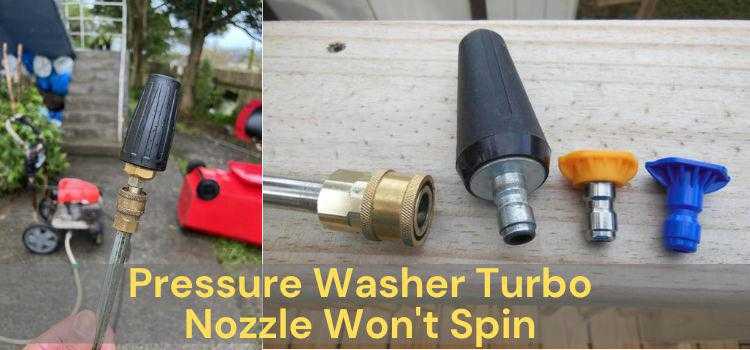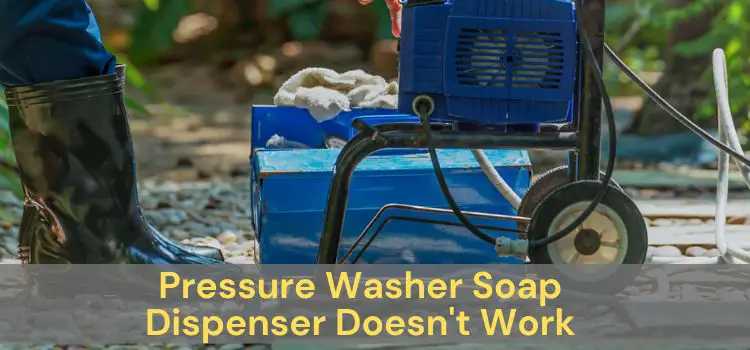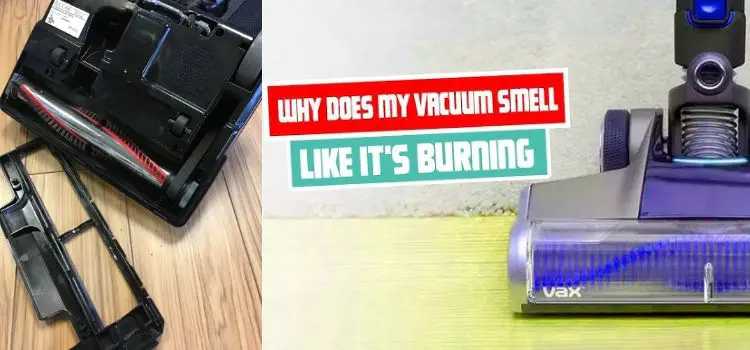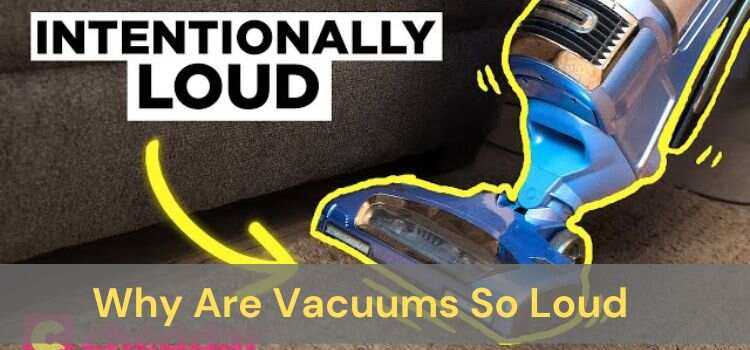· Troubleshooting · 9 min read
Pressure Washer Turbo Nozzle Won’t Spin: Quick Fixes!

A pressure washer turbo nozzle may not spin due to blockages or internal mechanical failure. Regular maintenance can prevent such issues.
Pressure washer turbo nozzles are essential for efficient cleaning. These nozzles combine the force of a narrow spray with a rotating motion, providing powerful cleaning action.
When they stop spinning, the cleaning performance drops significantly. Common reasons include blockages from debris or wear and tear on internal components.
Cleaning the nozzle or replacing worn parts can often resolve the issue. Regular maintenance, such as checking for debris and ensuring proper lubrication, helps keep the turbo nozzle functioning optimally.
Pressure Washer Turbo Nozzle Won’t Spin: Quick Fixes!
Understanding why your pressure washer turbo nozzle won’t spin can save time. This guide helps identify symptoms and clear up misconceptions. Let’s start with the basics.
Symptoms Of A Non-spinning Turbo Nozzle
The first sign is a lack of rotating spray. The water stream will be steady. Here are some common symptoms:
- Reduced cleaning power
- Unusual noises from the nozzle
- Visible debris in the nozzle
Common Misconceptions
Many believe the nozzle is broken. This is not always true. Here are some common misconceptions:
- Blocked Nozzle: Often, debris causes the blockage.
- Water Pressure Issue: Sometimes, low water pressure affects spinning.
- Incorrect Attachment: Ensure the nozzle is attached correctly.
By identifying these issues, you can quickly fix the problem.
Initial Troubleshooting Steps
Having trouble with your pressure washer turbo nozzle? Let’s look at some initial troubleshooting steps.
These steps can help get your nozzle spinning again. Follow this guide to solve common issues.
Safety Precautions
Safety comes first. Always wear protective gear. Use gloves and safety goggles. Make sure the pressure washer is off before inspecting. Ensure the nozzle is cool to touch.
- Wear gloves and safety goggles.
- Turn off the pressure washer.
- Ensure the nozzle is cool.
Basic Inspection Techniques
Start with a basic inspection. Check for any visible blockages. Look inside the nozzle for dirt or debris. Use a flashlight if needed.
- Inspect for blockages.
- Look inside the nozzle.
- Use a flashlight to see clearly.
Next, inspect the nozzle’s connection. Ensure it is firmly attached. A loose connection can cause issues. Tighten the nozzle if needed.
- Check the nozzle’s connection.
- Ensure it is firmly attached.
- Tighten if necessary.
Look at the nozzle’s tip. The tip should be clean. Remove any dirt or buildup. Use a small brush or a pin for cleaning.
- Inspect the nozzle’s tip.
- Ensure it is clean.
- Use a brush or pin to remove dirt.
Examine the o-rings and seals. Damaged o-rings can cause problems. Replace any worn or damaged o-rings. This simple step can fix many issues.
| Component | Action |
|---|---|
| O-Rings | Inspect and replace if damaged |
| Nozzle Tip | Clean thoroughly |
| Connections | Tighten if loose |
Water Pressure Considerations
When your pressure washer turbo nozzle won’t spin, the water pressure is often the culprit. Understanding the right pressure settings can save you a lot of trouble.
This section dives into the optimal pressure settings and the effects of low or high water pressure.
Optimal Pressure Settings
For a turbo nozzle to work correctly, it needs the right amount of pressure. The optimal pressure settings usually range between 2000 to 3000 PSI.
This pressure helps the nozzle spin efficiently, ensuring effective cleaning. Always refer to the manufacturer’s guidelines for the best results.
Using a pressure gauge can help monitor the PSI. Some pressure washers come with built-in gauges.
If your washer does not have one, you can buy it separately. Keeping an eye on the pressure ensures your turbo nozzle performs at its best.
Effects Of Low Or High Water Pressure
Low water pressure can cause the turbo nozzle to malfunction. When the PSI is too low, the nozzle may stop spinning. This leads to poor cleaning performance. The pressure washer might also make unusual noises.
High water pressure can also be problematic. Excessive PSI can damage the turbo nozzle. It may cause the nozzle to wear out quickly or even break. High pressure can also be unsafe, causing potential injuries.
Here is a quick comparison of the effects:
| Pressure Level | Effects on Turbo Nozzle |
|---|---|
| Low Pressure (below 2000 PSI) | Nozzle won’t spin, poor cleaning |
| Optimal Pressure (2000-3000 PSI) | Efficient spinning, effective cleaning |
| High Pressure (above 3000 PSI) | Nozzle damage, potential injuries |
To maintain your turbo nozzle, always check the water pressure before use. Adjust the settings to match the optimal range. Proper maintenance extends the life of your equipment.
Nozzle Maintenance Tips
Pressure washer turbo nozzles are vital for efficient cleaning. Proper maintenance ensures they work smoothly. Follow these tips to keep your nozzle in top shape.
Routine Cleaning Procedures
Regular cleaning is crucial for your turbo nozzle. Start by removing any visible dirt. Use a soft brush to scrub away grime. Rinse the nozzle with clean water. This removes loose debris.
Check the nozzle’s filter. Clean it if it’s dirty. Clogged filters reduce performance. Inspect the nozzle tip for blockages.
Use a needle or pin to clear any clogs. Always handle the nozzle gently to avoid damage.
Lubrication For Smooth Operation
Lubrication keeps your turbo nozzle spinning smoothly. Apply a small amount of lubricant to the moving parts.
This reduces friction and wear. Use a high-quality, water-resistant lubricant for best results.
Lubricate the nozzle’s bearings and joints. Follow the manufacturer’s recommendations for the type of lubricant.
Regular lubrication extends the life of your nozzle. It ensures consistent, powerful performance.
| Maintenance Task | Frequency |
|---|---|
| Clean Nozzle | After Each Use |
| Check Filter | Monthly |
| Lubricate Parts | Every 3 Months |
Following these tips keeps your pressure washer turbo nozzle in excellent condition. Regular maintenance ensures peak performance. Your cleaning tasks will be easier and more efficient.
Unblocking The Nozzle
Is your pressure washer turbo nozzle not spinning? A blocked nozzle can be frustrating. Unblocking the nozzle can restore its function. Let’s explore the tools and techniques needed to fix this issue.
Tools And Techniques
First, gather the necessary tools. You will need a few items:
- Thin wire or paper clip
- Clean water
- Small brush
- Protective gloves
Next, follow these steps to unblock the nozzle:
- Wear protective gloves.
- Disconnect the nozzle from the pressure washer.
- Use the thin wire to clear debris from the nozzle.
- Brush the nozzle with the small brush.
- Rinse the nozzle with clean water.
- Reconnect the nozzle to the pressure washer.
Flushing Out Debris
Sometimes, debris can get stuck inside the nozzle. Flushing out the debris is crucial. Here’s how to do it:
- Fill a bucket with clean water.
- Detach the nozzle from the pressure washer.
- Submerge the nozzle in the bucket.
- Swirl it around to dislodge any debris.
- Remove the nozzle and inspect it.
- Repeat if necessary until the nozzle is clear.
Regular cleaning can prevent blockages. Always inspect your nozzle after each use.
Checking For Wear And Damage
A pressure washer turbo nozzle that won’t spin can be very frustrating. One common cause is wear and damage. Regular checks can save you time and money. This section will help you identify signs of wear and decide when to replace the nozzle.
Spotting Signs Of Wear
Inspect the turbo nozzle closely. Look for any visible cracks or chips. Use a flashlight to check the nozzle tip. A worn tip can affect the spray pattern. Touch the nozzle to feel for rough edges or indentations. These can disrupt the water flow.
Another method is to check the water spray. If it’s uneven or weak, the nozzle might be worn. A good spray should be strong and consistent. Compare the current spray to when the nozzle was new.
When To Replace The Nozzle
If you spot any cracks, chips, or rough edges, replace the nozzle. These signs show the nozzle is damaged. A damaged nozzle can cause poor cleaning results.
Also, consider replacing the nozzle if the spray pattern is weak. A new nozzle can restore the pressure washer’s performance. Remember, using a damaged nozzle can harm your pressure washer.
Here’s a quick checklist to decide when to replace the nozzle:
- Visible cracks or chips
- Rough edges or indentations
- Weak or uneven spray pattern
Replacing the nozzle at the right time ensures your pressure washer works efficiently.
Systematic Approach To Diagnosing
When your pressure washer turbo nozzle won’t spin, it can be frustrating. Taking a systematic approach will save time and effort. This guide offers a clear, step-by-step process to diagnose the issue.
Step-by-step Diagnostic Process
- Check the Water Supply: Ensure water is flowing freely. Low water pressure can affect the nozzle.
- Inspect the Nozzle: Remove the nozzle and look for blockages. Small debris can stop it from spinning.
- Examine the Turbo Mechanism: Open the nozzle to check the turbo mechanism. Make sure it moves without resistance.
- Test the Washer: Connect the nozzle back and turn on the washer. Check if the nozzle spins now.
Eliminating Other Potential Issues
- Hose Blockage: Check the hose for any kinks or blockages. A blocked hose can reduce water flow.
- Inadequate Pressure: Make sure your pressure washer is delivering enough pressure. Low pressure can affect the nozzle.
- Faulty Nozzle: If the nozzle is old or damaged, it might need replacement. Inspect for wear and tear.
- Connection Points: Ensure all connections are tight and secure. Loose connections can lead to leaks and affect performance.
Professional Repair Vs. Diy
When your pressure washer turbo nozzle won’t spin, you face a dilemma. Should you call a professional or attempt a DIY repair? This section will help you decide which option suits you best.
When To Call A Professional
There are times when calling a professional is the best choice. Professionals have the right tools and expertise. They can diagnose the problem quickly. If your turbo nozzle is under warranty, a professional can help. They ensure that the repair doesn’t void the warranty.
- Complex Issues: If the problem is beyond basic troubleshooting.
- Warranty: If your nozzle is still under warranty.
- Specialized Tools: If you lack the necessary tools.
Diy Repair: Pros And Cons
DIY repairs can be cost-effective and satisfying. But they come with their own set of challenges.
| Pros | Cons |
|---|---|
| Save Money | Risk of Mistakes |
| Learn New Skills | Time-Consuming |
| Immediate Action | Need for Tools |
Consider these points before starting a DIY repair. If the problem seems too complex, always seek professional help.
Credit: espanol.ryobitools.com
Frequently Asked Questions
Why Is My Gerni Turbo Nozzle Not Working?
Your Gerni turbo nozzle might be clogged, damaged, or improperly connected. Check for debris and ensure secure attachment.
Do Pressure Washer Turbo Nozzles Work?
Yes, pressure washer turbo nozzles work effectively. They combine high pressure with a rotating jet, cleaning surfaces quickly and efficiently. Ideal for tough grime and large areas.
Why Is My Bosch Rotary Nozzle Not Spinning?
Your Bosch rotary nozzle may not spin due to blockages, worn-out components, or insufficient water pressure. Clean the nozzle, check for debris, and ensure adequate water flow.
How Does A Rotating Pressure Washer Nozzle Work?
A rotating pressure washer nozzle spins a narrow, high-pressure water jet in a circular motion. This increases cleaning power.
The spinning action combines high impact and wide coverage, making it effective for removing stubborn dirt and grime.
Conclusion
Fixing a pressure washer turbo nozzle that won’t spin is essential for effective cleaning. Regular maintenance helps avoid issues. Check for clogs and clean the nozzle.
Replace damaged parts promptly. Ensure proper water pressure for optimal performance. Follow these steps to keep your pressure washer in top condition and enjoy efficient cleaning.
- Turbo nozzle
- Pressure washer
- Troubleshooting




